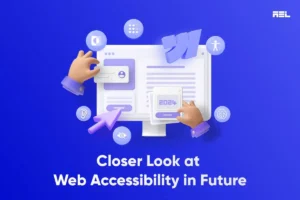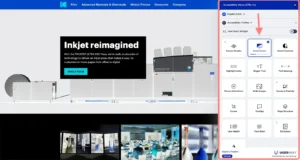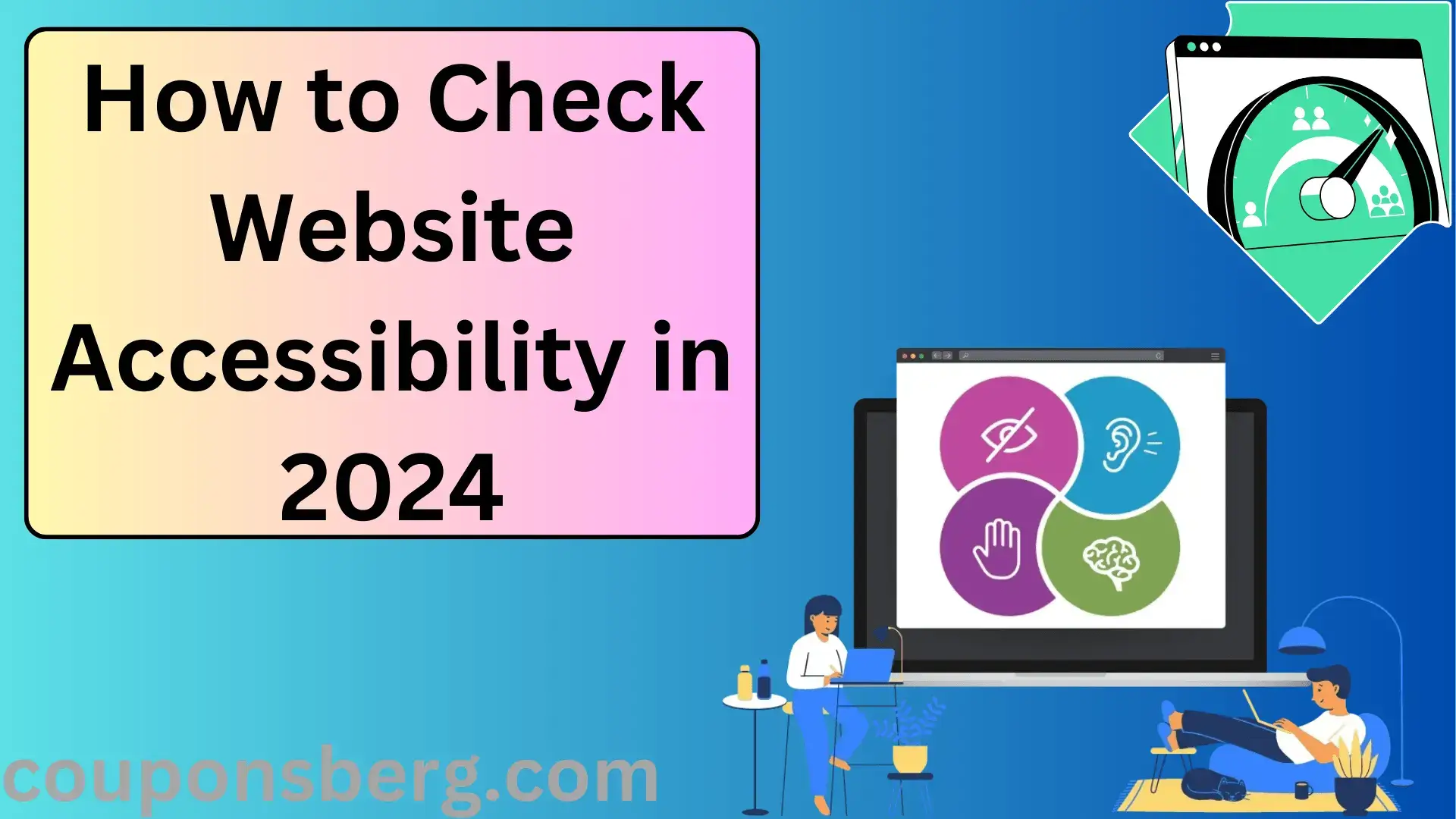Website Accessibilityc : Approximately 5.3 billion individuals have access to the internet worldwide.As a result, there is an enormous range of variety and requirements on the internet, making it imperative for businesses with an online presence to be even more accessible and inclusive.
Making sure your website is adequately accessible now may help you avoid compliance concerns and costly retrofitting later on, as accessibility laws become more stringent.
Is it time to review the accessibility of your website?
Always keep in mind that the goal of accessibility is to enhance user experience for all users, including those who are disabled. Additionally, accessible technology can support your website dynamically as it grows, even while information is always changing and undergoing upgrades.
Here are a few simple steps to check for and fix accessibility issues on websites.
What is Website Accessibility?
The development and design of websites that are usable by individuals with diverse abilities is referred to as website accessibility.

Websites should, for instance, be able to meet the demands of users with a variety of needs, such as those who have cognitive disabilities, motor control issues, hearing loss, or vision impairments.
Accessibility features can improve the user experience overall by lowering friction and annoyance levels. Examples of these features include colour contrast, larger font, compatibility with screen readers, keyboard shortcuts, and larger cursors.
It is the duty of all organisations to ensure that their websites are user-friendly and accessible to everybody, without alienating any particular user demographic.
Economically speaking, accessibility makes perfect sense: all people should have access to the technologies necessary for daily living, such as internet purchasing and video consumption.
Making your website’s offers as comprehensive as possible will help you connect with more people.
Why Website Accessibility is a Must-have for All Organizations
Better accessibility will enable you to accommodate the wide range of user needs. Even better, you’ll be equipped to provide all of your customers and site visitors with an excellent user experience.
When watching video, closed captions, for instance, help younger viewers avoid distractions and accommodate those with visual impairments.
Additional features for accessibility encompass text-to-speech, keyboard navigation, alt text, and colour contrast.
Compliance and User Needs: An On-going Responsibility
From the standpoint of usability, accessibility might be a shifting target that changes based on user requirements. Because of this, user and website testing are difficult yet crucial components of accessibility.
Accessibility compliance is just as dynamic. The most recent guidelines for websites to be accessible are outlined in the Web Content Accessibility Guidelines (WCAG) and the ADA guidelines for Accessible Designs. It’s critical to stay informed as compliance regulations become more stringent and as technology advances.
With the aid of these tools, you can improve the accessibility of your websites and lower the chance that you will unintentionally break any laws and face legal action.
How to Check Website Accessibility in 5 Steps
You can manually review and enhance the accessibility of your website using these methods. While they are a good place to start for accessibility, greater inclusivity should be achieved by building upon them.
1. Add Closed Captioning for All Videos and Audio Content
As seen in the screenshot above, closed captions, often known as subtitles, are text that is displayed either in tandem with audio or visual material.
They help those who could be in noisy environments and those who have hearing problems. Additionally, transcripts can frequently improve your SEO efforts.
When users watch your material, most video hosting services allow them to enable closed captioning. Make sure this option is activated and verify that it functions by reading the text yourself.
2. Include Alt text for Images
A written description for non-text content, such as pictures and videos, is called alt text (alternative text). It helps your users understand the objects on the screen thanks to assistive devices like screen readers.
You can notice the alt text “Baby the Corgi Puppy” in the screenshot up above. In the event that the image is not adequately displayed, this alt text loads as well.
Content can have alt text added by using your website hosting platform. Make an effort to be as precise, succinct, and educational as you can.
Use free accessibility scanner tools to find missing alt text as well. It’s crucial to remember that although a tool can identify content lacking alt text, it is unable to determine whether the alt text you do have is sufficiently accessible.
3. Ensure Color Contrast
The difference in brightness between your website’s foreground and background features is known as colour contrast. People will find it easier to read and navigate your website the more of a difference there is.
In addition to helping the majority of people avoid eye strain, strong colour contrast is extremely beneficial for those who suffer from colour blindness and other visual impairments.
The Web Content Accessibility Guidelines (WCAG) state that a colour contrast ratio of 4.5:1 is ideal for text and text-image combinations. A minimum of 3:1 contrast should be present in both huge text and its image.
This free tool from a11y, a community-driven project to make accessibility easier, can indicate colour contrast concerns on your website, making these tech specifications easier to follow.
4. Test Keyboard Navigation
Users can navigate your website without using a mouse by using keyboard navigation. It lets users use keyboard controls to scroll, open links, and perform other operations. This holds significance for people with restricted mobility.
For keyboard navigation to function well, a user must be able to see clearly where they are on a page and what actions they can take. For instance, in order for a user to choose an input for a form, a drop-down menu might need to show.
- Try utilising just your keyboard to accomplish tasks on your website.
- If any flows are unclear or any elements are out of your reach, make a note of them.
- Urge your teammates to follow suit, and report any obstacles as problems with accessibility that need to be fixed.
5. Use Heading Styles Correctly
The H1, H2, H3, and so on heading structures indicate the order of material on your page. These aid users in understanding the text’s flow and overall messaging in addition to making content appear more organised.
These headings assist readers of your website who are visually impaired while also providing information to screen readers.
This page actually uses H3 headings for any subsections, and you’ll see that it contains several H2 headers that break up the text’s major sections.
Either through the backend of your website or by right-clicking on any page and choosing “inspect,” you can examine your heading structures. You can see pages without heading styles using a variety of free programmes.
Accessibility Testing Tools
There are many resources and tools available to make the process of accessibility checking your website easier. These tools can expedite the process of developing and implementing an accessibility plan by automating checks.
Use caution when combining these tools with manual verification and extensive user testing; after all, accessibility ought to be created by humans, for humans.
One software from UserWay’s accessibility compliance platform is called Accessibility Scan and Monitor. The application employs artificial intelligence (AI) to verify if links, photos, videos, and form fields on websites are compliant with WCAG and ADA.

In less than an hour, the scan and monitor programme can perform up to 30,000 scans across 15,000 pages. It also looks for problems that only show up on particular-sized displays and devices.

The AI Accessibility Widget is a fantastic solution from UserWay that continuously and automatically detects and corrects numerous accessibility compliance problems. This aids in ensuring that websites adhere to the most recent WCAG and ADA accessibility guidelines.

The Widget adds a menu of accessible choices to your website so that users can browse and improve its usability. Because it provides 57 different languages for localised customer assistance, more users from more places may interact with your website.
Additionally, AI Accessibility Widget features a multilingual text-to-speech voice tool that is responsive.
These two methods enable businesses to reach new markets and have even been connected to higher click-through rates, higher earnings per click, lower bounce rates, and higher conversion rates.
Take Advantage of These Accessibility Tools
Couponsberg subscribers (on any plan, including the free plan) can obtain the AI Accessibility Widget and the Accessibility Scan and Monitor for free. To locate them and begin, just go to the Semrush App Centre.
Accessibility and marketing are intertwined. While marketing may highlight and portray your brand’s accessible nature, an accessible website naturally enhances your brand’s voice.
It is possible to handle both more thoroughly and successfully if you have accessibility tools in your marketing toolbox.
What Are the Types of Accessibility Testing?
The users you are catering to can be the emphasis of accessibility testing as opposed to rigid sorts of testing. Testing will remain human-centric in this sense. You could focus your testing on the following groups, among others:
- Individuals who are visually impaired
- Individuals who are hard of hearing
- Individuals with limited mobility
- individuals with cognitive or learning difficulties
In order to ensure that websites are accessible to these groups, you should make an effort to test in each of the following ways:
- Manual testing: Ask team members to test the website’s flows on their own and report any obstacles.
- Automated testing: use programmes that find, address, and highlight accessibility issues on a regular basis.
- User testing: Interview a wide range of people on a regular basis to learn about their experiences with your website’s accessibility.
How to Check ADA Compliance
The minimal specifications for creating an accessible website are outlined in ADA guidelines. It is the document that is most frequently cited for accessibility, along with WCAG.
Any business that serves the public good is legally required to follow ADA guidelines. The penalty of breaking the ADA can be high; by the end of 2023, 4,220 cases with an average value of $25,000 each case are expected to be reported on ADA websites.
Start by utilising the above-mentioned tools and free tools to verify your ADA compliance. As always, test your website often with a wide range of actual users.
The ADA has several guidelines, however the following are the fundamental ones for your website:
- Perceivable—all features and content are readily apparent.
- Operable: Any user can engage with the UI and navigate it.
- Robust: assistive devices are able to interpret all of the content.
- Comprehendable: all data is readily assimilated, enabling users to navigate the website with ease and knowledge.
Address Your Web Accessibility Today
Being accessible is a process rather than a final goal. The sooner you begin addressing your website’s accessibility, the faster you’ll be able to pinpoint problem areas and implement the necessary adjustments to build an inclusive website.
By doing this, you reduce the possibility of legal action, exhibit your social duty, and create more opportunities for users to visit and enjoy
With Accessibility Scan and Monitor and AI Accessibility Widget, implementing accessibility is now simpler than ever.
>>GET MORE INFORMATION SO VISIT ….Couponsberg.com
FAQs :Website accessibility
1. What is website accessibility?
Website accessibility means designing and developing websites so that people with disabilities can use them. This includes making sure that all users, regardless of their abilities, can perceive, understand, navigate, and interact with the web effectively.
2. Why is website accessibility important?
Website accessibility is crucial because it ensures that everyone, including people with disabilities, can access and use online information and services. It promotes inclusivity and equal access, and it’s also often required by law.
3. Who benefits from accessible websites?
Accessible websites benefit everyone, including people with disabilities, older adults, people with temporary impairments (like a broken arm), and those with situational limitations (like bright sunlight or noisy environments).
4. What are some common barriers to website accessibility?
Common barriers include:
- Lack of alternative text for images
- Poor color contrast between text and background
- Non-accessible forms
- Lack of keyboard navigation support
- Videos without captions or transcripts
5. What is alt text and why is it important?
Alt text (alternative text) is a short description of an image that is read by screen readers used by people who are blind or have low vision. It provides context and information about the image, making the web content accessible to all users.
6. How can I test my website for accessibility?
You can test your website using various tools and methods, such as:
- Automated tools like WAVE, Axe, or Lighthouse
- Manual testing with screen readers (e.g., NVDA, JAWS)
- Checking for keyboard accessibility
- Ensuring proper use of HTML semantic elements
7. What are some simple steps to improve my website’s accessibility?
To improve accessibility, you can:
- Add alt text to images
- Use headings correctly (H1, H2, etc.)
- Ensure sufficient color contrast
- Make sure forms are labeled properly
- Provide captions and transcripts for multimedia
- Allow keyboard navigation
